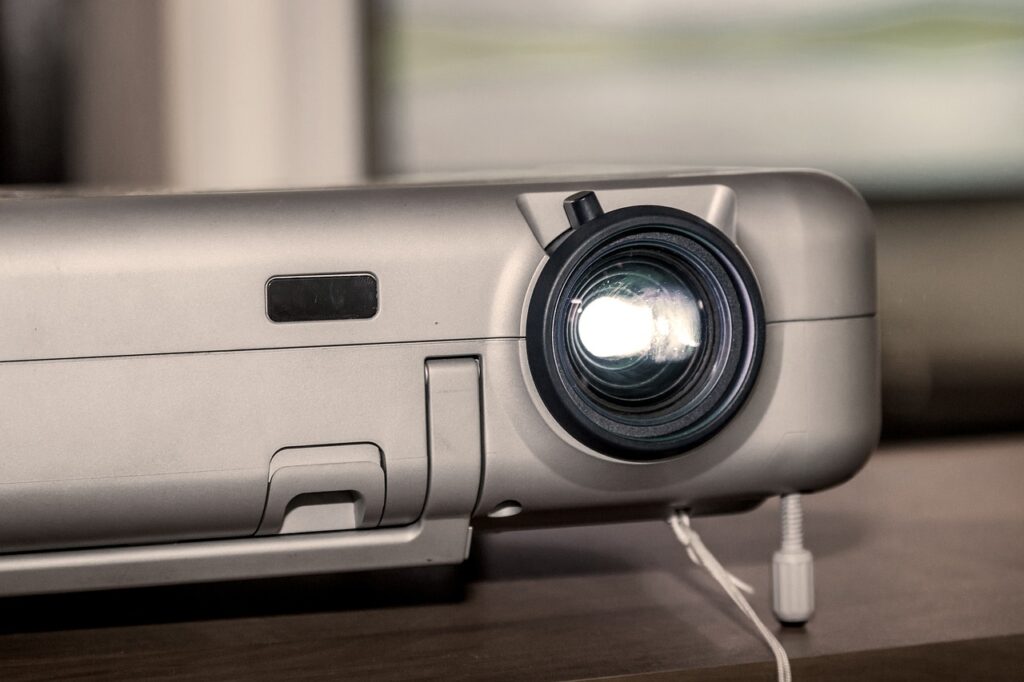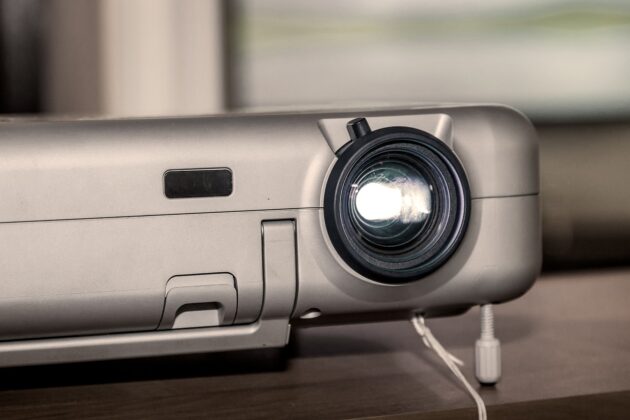
Effectiveness and productivity in the rapidly evolving modern workplace can be significantly impacted by having the right technology. Among the devices whose worth has grown over time is the projector. Whether setting up a home office, updating a conference room, or creating a collaborative space, a good projector can make all the difference in your workspace. This article will not only teach you what factors to look for when buying a projector but also assist you in choosing the best projector for your needs.
Table of Contents
The Advantages of Setting Up a Projector in Your Office
A projector is more than just a presentation tool; it can transform how you work. Here are some of the benefits of incorporating a projector into your workspace:
- Larger Display Area: Unlike traditional monitors, projectors can display content on a much larger scale. Communicating with people is easier not only in meetings but also during group assignments. This display is also advantageous for detailed work such as graphic design, data analysis, or document review because it needs clarity and visibility.
- Versatility: Projectors can be used for various purposes, from presentations and video conferences to displaying multiple windows or documents simultaneously. Their adaptability to various tasks and requirements makes them valuable to any workspace.
- Improved Collaboration: The projector enhances communication, picking up the same content for everyone to look at from their positions, thus enabling better teamwork. You can use it to brainstorm ideas, conduct training, or assess a project, ensuring that all members of the group are following together.
- Space-Saving: Compared to big monitors and several displays, projectors can simply be attached to the wall or ceiling, saving much space on the table. This is particularly important in smaller offices where it is essential to use every inch.
- Improved Visual Impact: Projectors can significantly improve the quality of your presentations and displays. High-resolution projectors provide sharp and clear images that enhance the visual impact of your content. This is especially important when making presentations to clients or stakeholders because professionalism and clarity are essential in such cases.
Key Features to Look for in a Workspace Projector
When selecting a projector for your workspace, it’s essential to consider several key features to ensure it meets your needs. Here’s what to look for:
- Resolution: A projector’s resolution determines the clarity and detail of the image projected. It is recommended that any projector meant for work purposes have at least 1080p (Full HD) resolution. For even better picture quality, you may consider buying a 4K projector such as the JMGO 1, mainly if your job involves dealing with high-resolution pictures or videos.
- Brightness: Brightness is measured in lumens; the greater the figure, the more illuminated the picture. Most workplaces should have a projector whose brightness is between 2,500 and 3,500 lumens. A projector emitting more light would be good if your working area has plenty of daylight or you want to use it in a vast space.
- Contrast Ratio: The measure of how bright and dark something is used to calculate the contrast ratio. Higher contrast ratios result in better-quality images with more distinct colors and details. A projector should have a contrast ratio of at least 10,000:1 for it to perform optimally.
- Connectivity Options: Make sure that the projector you select has various connecting choices, including HDMI, USB, and wireless functionalities. This means it will be easy to link different gadgets, including laptops, tablets, and even streaming gadgets. Moreover, wireless linking is appropriate for minimizing messiness and making it simple to toggle between devices at a meeting or presentation.
- Portability: If you will be switching the projector from one room to another or applying it in jobs from afar, producing mobile kind is necessary. Mobile projectors are light in weight and simple to install, which makes them perfect for workplaces that require adaptability.
- Lamp Life: Choose a projector with a bulb that lasts more than 10,000 hours of use to minimize additional maintenance expenses and ensure continuous use.
- Built-In Speakers: Several projectors possess speakers integrated within them. However, for all work environments, their sound quality might not be enough. If audio is crucial during your presentations or video conversations, pairing the projector with distinct loudspeakers or soundbars is recommended, as they provide good sound quality.
Choosing the Right Projector for Your Workspace
With so many options available, choosing the right projector for your workspace can be challenging. Here are some tips to help you make the best decision:
Assess Your Needs
Consider how you plan to use the projector. Are you primarily using it for presentations, video conferences, or collaborative work? Do you need a projector that can display high-resolution images or videos? Understanding your specific needs will help you narrow down your options.
Consider the Space
The size and layout of your workspace will impact the type of projector you need. If you have a small office, a short-throw projector that can display a large image from a short distance might be ideal. For larger rooms, a standard or long-throw projector might be more suitable.
Budget
Projector costs fluctuate widely, so you need to establish a budget before sourcing one. Although it might appear appealing to select the least expensive option available, always think carefully because a quality projector is really an investment in your professional life and productivity levels. Look at the bigger picture and go for a model that effectively combines features and price in the long run.
Read Reviews
Before making a purchase, it is advisable to go through some user reviews so that you can gauge its effectiveness, robustness, and usability. Also, ensure that you concentrate on those reviews that explicitly mention the usage of those projectors in an office setting because this would provide you with more insight into how the projector operates within your office.
Test Before You Buy
If possible, test the projector in your workspace before deciding. This will allow you to see how it performs in your specific environment and ensure it meets your needs.
Tips for Optimizing Your Workspace Projector Setup
Once you’ve chosen the right projector, setting it up correctly is vital to get the best performance. Here are some tips for optimizing your workspace projector setup:
Positioning
Place the projector right from the screen or wall to ensure a clear and appropriately sized image. Follow the manufacturer’s guidelines for the optimal throw distance.
Screen or Surface
For the best image quality, use a proper projector screen or a smooth, white wall. Avoid projecting onto textured or colored surfaces, which can distort the image.
Lighting
Minimize ambient light in the room to enhance the projector’s brightness and contrast. Consider using blackout curtains or shades if the room has a lot of natural light.
Cable Management
Organize cables and wires to keep your workspace tidy. Use cable clips or ties to prevent tangling and ensure easy connection access.
Regular Maintenance
Keep the projector clean and dust-free to maintain optimal performance. Regularly check the lamp life and replace the bulb when necessary to avoid interruptions.
Final Thought
Getting a projector that suits your workspace can improve your work experience, encourage teamwork, and improve productivity. Choosing the appropriate type of projector and modifying the workplace organizes it so that it is conducive to work effectively, and so on. A projector is one of the best gadgets used to increase efficiency regardless of where you are working; these include home offices, conference rooms as well as participatory workspaces
